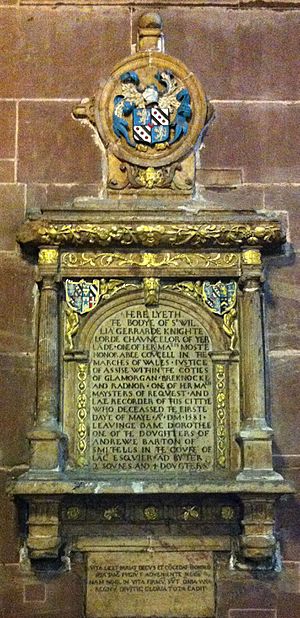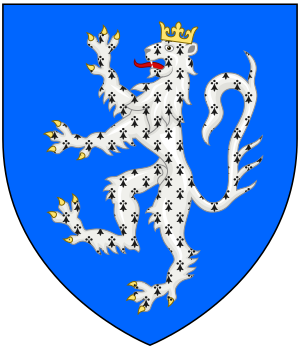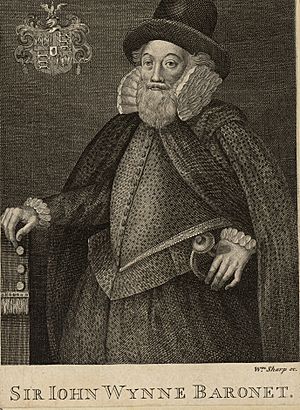William Gerard facts for kids
Sir William Gerard (1518–1581) was an important government official during the time of Queen Elizabeth I. He served in England, Wales, and most notably in Ireland. He was a member of the House of Commons for Chester for many years. He also held a high position as Vice-President of the Council of Wales and the Marches.
For five years, he was the Lord Chancellor of Ireland. This was a very important legal job. Historians often praise his strong efforts to make the Irish legal system better. Even though he was not a clergyman (a religious leader), he was made Dean of St Patrick's Cathedral, Dublin in 1573. He even said he felt a bit "uneasy" about having a church job.
Contents
Early Life

William Gerard was born in Ince-in-Makerfield, Lancashire. His father was Gilbert Gerard. His mother was Elizabeth (or Eleanor?) Davison, whose father was an important official in Chester. William would have a long connection with Chester, and he died there. Sir Gilbert Gerard, a famous English judge, was his cousin. It is believed that his cousin helped William's career.
Becoming a Lawyer
William started studying law at Gray's Inn in 1543. He became a lawyer in 1546. By 1552, he was given the title of "Ancient of Gray's Inn." This title was usually given to lawyers who had worked at the Inn for ten years. Some people thought his legal training was not enough for the job of Lord Chancellor of Ireland. However, William had gained a lot of legal experience. He became Attorney General for Wales in 1554. He was made Recorder (a type of judge) of Chester in 1556. He also served as a justice in Wales in 1559 and vice-justice of Chester in 1561.
A Career in Government
Starting in 1555, Gerard was elected to the House of Commons six times in a row. He represented Chester. He served during the last two parliaments of Queen Mary's reign (1555 and 1558). He also served in the first four parliaments of Queen Elizabeth's reign (1559, 1563, 1571, and 1572).
Helping Govern Wales
In 1560, Gerard became a member of the Council of Wales and the Marches. This council helped govern Wales and the border areas. By 1562, he became the Vice-President of the Council. He became known as a very active and effective administrator. He was also keen on making improvements. Because of this, the Lord Deputy of Ireland, Sir Henry Sidney, asked for him to be appointed Lord Chancellor of Ireland in 1576.
The Lord Chancellor job had been empty for three years. Sidney wanted a very dedicated person to help him with his big plans for reform. Sidney had worked with Gerard in Wales and thought very highly of his skills. For some years, they were close friends. Gerard even named one of his daughters, Sidney, perhaps as a tribute to their friendship. She later became Lady Wynn.
Lord Chancellor of Ireland
When William Gerard arrived in Ireland, he had good intentions. He quickly showed himself to be a very active and capable Lord Chancellor. He announced his plan to spread the assize system across Ireland. This system involved judges traveling to different parts of the country to hold court. His goal was to bring back public order and deal with serious crime. He quickly set up regular court sessions in the east and south-east of Ireland.
Some historians say that traveling so often for court made him neglect his main duties in Dublin. At first, he wanted to remove most of the Irish-born High Court judges. He called them "scarecrows" and "mere shadows," saying they were too old and unfit. He asked for English judges to replace them. However, later he was willing to accept Irish judges if they had enough legal skill.
Ideas for Ireland
Gerard believed that many English settlers should move to Ireland. He wrote about the sad and hungry state of the native Irish people. Some parts of the country had almost no people left. He also noted that the country was full of thieves. He thought all thieves should be hanged, saying "English justice must be the executioner." He did not think highly of his Irish civil servants, saying he found "not one good man among the whole crew." By March 1577, he insisted he needed English lawyers to help him. He claimed the job would kill him otherwise.
Historian Crawford says that Gerard, as Lord Chancellor, had two main goals. First, he wanted to bring back the authority of the common law courts across Ireland. Second, he wanted to make the Court of Castle Chamber more effective. This court was the Irish version of the English Star Chamber. It had been set up in 1571 to help maintain public order. In his early years, he was quite successful with the second goal. Castle Chamber heard many cases about riot, affray, and other crimes against public order. Gerard was praised for how carefully he investigated cases and how he worked to solve them.
The number of public order cases in Castle Chamber was so high that in 1579, he apologized to Lord Burghley. He explained he could not hear a private case that Burghley was interested in. One important private case was brought against the 8th Baron Howth. He was accused of being cruel to his wife and daughter Jane. The court found evidence that he had beaten his wife so badly she feared for her life. Jane had died soon after a similar beating, likely because of it. Given Lord Howth's high social standing, the punishments were quite serious. He was briefly put in prison, had to pay large fines, and was ordered to pay money to his wife. She was allowed to live separately from him and keep their children.
Gerard deeply studied the history of English rule in Ireland. He also looked into why the Crown had failed to control the entire island.
Later Years and Death
William Gerard's efforts to improve the Irish legal system slowed down in his later years. His disagreements with Sidney, Sidney's return to England, and a major rebellion in 1579 (the second Desmond Rebellion) stopped the push for big changes. Ambitious plans for full judicial circuits (where judges travel to all parts of the country) were put on hold. Gerard had often been sick during his years in Wales. He complained that the damp Irish weather affected his health. He was also over sixty, which was quite old for that time.
From 1579 onwards, he was very ill. He suffered from dysentery, had trouble breathing, severe leg pains, and a skin disease. He spent most of his last years in Chester, with only a few visits back to Ireland. In 1579, he was made a knight. The Queen even sent one of her own doctors to treat him.
By 1580, it was clear he would not live much longer. The Queen allowed him to retire to Chester. He had planned to visit London in March that year, but found himself "lame beyond hope of recovery." He wrote a loyal letter to Elizabeth I. He said he hoped to see her one more time, even if he had to crawl all the way to London. But he was too ill to leave Chester. He died there in early May 1581. He was buried in St. Oswald's Church, Chester, which was then part of Chester Cathedral. His monument can still be seen there. Much of his will describes his money problems and the difficulties he had providing for his family.
Family
Gerard married Dorothy Barton. She was the daughter of Andrew Barton of Smithhills, Bolton, Lancashire. Her mother was Anne Stanley. Some of Dorothy's family were recusants (people who refused to attend Church of England services). However, Dorothy, like her husband, seemed to be a strong Protestant. Dorothy outlived him, even though in his will he mentioned her frequent and serious illnesses. They had two sons and four daughters:
- Gilbert, the oldest son, later became a Member of Parliament for Chester. He married Ellen Pearson.
- Elizabeth (died 1626) married Thomas Leighton. He was an MP for Shropshire. They had seven children. Their descendants became the Leighton baronets.
- Sidney (died 1632) married Sir John Wynn, 1st Baronet of Gwydir Castle. They had 12 children, including Sir Richard Wynn, 2nd Baronet and Sir Owen Wynn, 3rd Baronet.
- Judith was still unmarried when her father died. She received a good amount of money in his will.
- Margareta received something from the will. She married Richard Marten and had one daughter named Dorothy. Margareta died in 1637.
What People Thought of Him
Historians generally agree that Gerard started his work in Ireland with a lot of energy. He tried hard to improve the legal system. Some historians, like Elrington Ball, suggest he soon gave up on reforms. They also say he neglected his main job and got involved in things that were not his business. Ball also criticizes him for accepting the Deanery of St Patrick's, even though he was not a priest. However, it's worth noting that the previous Lord Chancellor, Robert Weston, was also a layman (not a priest) and also Dean of St. Patrick's.
Ball also hinted that Gerard might have been involved in corruption. However, there is little proof of this. When Gerard mentioned his "wicked life" in his will, it might just have been a common phrase reflecting his Puritan belief that all humans are naturally sinful.
On the other hand, historian O'Flanagan describes Gerard as a very active and careful Lord Chancellor. He believes Gerard probably harmed his own health by working too hard. Crawford goes even further, praising Gerard as an outstanding Chancellor. He calls him an energetic and capable reformer. Crawford says that in his early years in Ireland, Gerard did a lot to bring back the authority of the courts. The case of Lord Howth shows that Gerard was willing to give fair justice, even against powerful noblemen.



